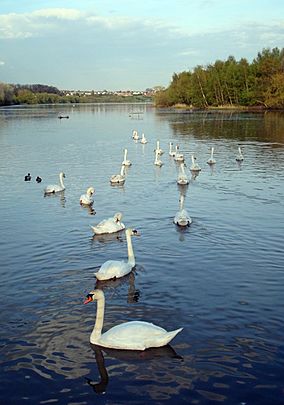Fairburn Ings RSPB reserve facts for kids
Quick facts for kids Fairburn Ings RSPB Reserve |
|
|---|---|

Flotilla of mute swans with Fairburn village on the horizon
|
|
| Location | West Yorkshire, England |
| Operator | Royal Society for the Protection of Birds |
| Website | http://www.rspb.org.uk/reserves/guide/f/fairburnings/index.asp |
Fairburn Ings Nature Reserve is a special protected area in West Yorkshire, England. It is well-known for its amazing variety of birds. Around 280 different bird species have been seen here. This is a lot for a place that isn't on the coast in the United Kingdom. This happens because the reserve is on important migration routes. It also has many different types of habitats for birds to live in.
Contents
History of Fairburn Ings
Fairburn Ings was officially made a local nature reserve in 1957. This happened under a law called the National Parks and Access to the Countryside Act. Since the late 1970s, the Royal Society for the Protection of Birds (RSPB) has looked after the reserve. They manage it for the local nature lovers who first created it.
Exploring Fairburn Ings Geography
The reserve is located in the Lower Aire Valley. You can find it south and west of Fairburn, close to Castleford. It includes the entire Fairburn & Newton Ings SSSI. An SSSI is a place that is very important for science.
What "Ings" Means
The word ings comes from an old Norse word. It means "damp or marshy land that floods." This name fits perfectly because the River Aire often floods this area.
Lakes and Landscapes
Fairburn Ings is right next to the River Aire. This nature reserve is about 1,000-acre (400 ha) big. It has one large lake and many smaller lakes, ponds, and channels called dikes. For about 150 years, this area was used for industry and coal mining. The valley naturally floods, but the permanent lakes you see today were formed differently. They appeared when the ground sank because of old coal mines, some as deep as 600 metres (2,000 ft) underground. These sunken areas created perfect homes for wildfowl (water birds) and many other birds.
Surrounding Areas and Habitats
The land around the reserve is mostly farms to the north and east. To the south and west, you'll find towns and cities. About one-third of the reserve was created from 26 million cubic metres of waste from coal mining. This waste was shaped into a beautiful landscape. It now has grassy areas with many different plants, wet marshy areas, and woodlands.
Fairburn Ings has many types of habitats. These include flood meadows, wet fenland, marsh, reed beds, woodlands, and scrub. These habitats are important for protecting nature in the UK.
Special Habitats and Animals
The reserve has several important habitats listed in the UK's plan to protect nature. These include:
- Lakes with a medium amount of nutrients, called mesotrophic lakes.
- Areas filled with tall reeds, known as reedbeds.
- Grassy fields in low areas, called lowland meadows.
Many special animals live in these habitats. Some of these are:
- Grey partridge (Perdix perdix)
- Turtle dove (Streptopreptopelia turtur)
- Skylark (Alauda arvense)
- Song thrush (Turdus philomelus)
- Tree sparrow (Passer montanus)
- Linnet (Carduelis cannabina)
- Bullfinch (Pyrrhula pyrrhula)
- Reed bunting (Emberiza schoeniclus)
- Corn bunting (Milaria calandra)
- Water vole (Arvicola terrestris)
- Pipistrelle bat (Pipistrellus pipistrellus)
Birds Needing Protection
Some birds at Fairburn Ings are of special concern for conservation. This means they need extra protection. These birds include:
- The black-necked grebe (Podiceps nigricollis)
- Garganey (Anas querquedula)
- Redshank (Tringa totanus)
- Whooper swan (Cygnus cygnus)
- Golden plover (Pluvialis apricaria)
Visitor Facilities
Fairburn Ings has a visitor centre where you can learn more. There are also five hides. These are special shelters where you can watch birds without disturbing them. It's free to enter the reserve, but there is a small charge to park your car.
Images for kids




